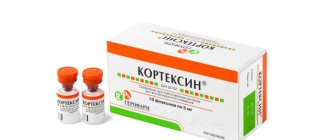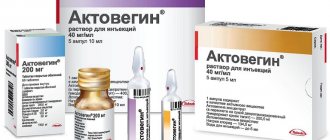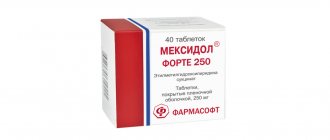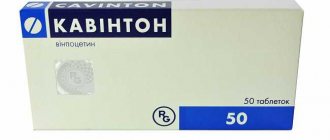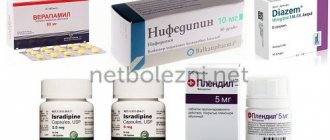Nootropic drugs with a wide spectrum of action against cerebral circulatory disorders are quite common in our country. Two drugs from this group are in great demand among clinicians – Cortexin and Mexidol.
They are successfully used for the purpose of both pharmacotherapy and pharmacoprophylaxis: they have a direct effect on learning processes, memory, mental activity, and increase the brain’s resistance to any adverse effects. But what is better to choose, let’s try to figure it out further.
How they affect the body
Cortexin contains an active element that consists of a low molecular weight peptide from the brain of pigs and cows. The effectiveness of this medication is based on the stabilization of metabolic processes in nerve cells. The active substance helps to enhance the protein-synthetic functionality of tissues. Cells are protected from oxidation and hypoxia. The drug helps restore memory after traumatic brain injury, stroke and the onset of neurodegenerative diseases.
Mexidol is considered an antihypoxic agent. Its effect is aimed at optimizing energy processes in neurons. The drug improves the protection of cell membrane lipids from oxidative processes and reduces the susceptibility of brain tissue structures to a lack of oxygen.
General information about Cortexin
Cortexin is a modern medicine whose structure is based on polypeptide chains. It is produced on the basis of an extract from the cerebral cortex of cattle and pigs. The composition of this medicinal substance is completely free of prion proteins.
It has been clinically proven that Cortexin has virtually no side effects and has no contraindications for use. Its characteristic properties are the absence of toxicity, allergenicity, immunogenicity, carcinogenicity and teratogenicity. Efficiency is manifested both in monotherapy and in combination with traditional, standardized methods of treatment.
Cortexin is a lyophilized powder for preparing a solution. The active substance is based on complexes of water-soluble polypeptide chains. Dosage – 5 mg and 10 mg. Additionally, the composition contains glycine, which acts as a stabilizer. Thanks to this combination, high nootropic effectiveness is achieved.
Which is better: Cortexin or Mexidol?
Which drug is best can only be determined by the attending physician based on the indications and condition of the patient. Both medications exhibit nootropic, neuroprotective, antioxidant and tissue-specific effects. The mechanism of action of the drugs is similar, but the difference lies in the price.
The principle of action of the drugs
Both drugs have completely different mechanisms of action:
- The mechanism of action of Cortexin is based on its ability to penetrate the BBB. It also directly regulates the content of cyclic nucleotides in the human body. Thus, muscle fibers relax, blood vessels dilate and the volumetric velocity of blood flow in tissues subject to ischemia increases.
Cortexin improves cerebral blood flow and reduces vascular resistance, does not affect the characteristics of general blood circulation (blood pressure, pulse, total peripheral vascular resistance), improves blood circulation in the affected area, and the blood circulation in the healthy area does not change.It is a vasoactive agent that improves cerebral circulation, enhances the utilization of sugar and oxygen by brain tissue, and increases the brain's resistance to hypoxia.
It also affects the activity of all types of amino acids, the level of neurotransmitters (dopamine and serotonin) in the blood, and has antioxidant properties. While taking Cortexin, neuropsychological indicators improve: concentration and memory increase, anxiety levels decrease, and performance increases.
- The second nootropic, Mexidol, has antioxidant and membrane protective effects, which ensure stabilization of the cell biomembrane and affect the synthesis of prostaglandins. The active ingredient of the drug increases the content of polar lipid particles, reduces the viscosity of the lipid layer and increases membrane permeability, reduces the cholesterol/phospholipid ratio.
Clinical effects of MexidolThe product realizes its properties at three levels - neural, vascular and metabolic. Mexidol reduces pulse blood supply in the vessels of the carotid blood supply and increases it in the vertebrobasilar region due to its ability to penetrate the blood-brain barrier.
Indications for use
The instructions for use indicate that Mexidol is prescribed for:
- acute disturbance of blood flow in the brain,
- traumatic brain injury,
- neurocirculatory dystonia syndrome,
- the occurrence of anxiety,
- myocardial infarction,
- development of primary open-angle glaucoma,
- the appearance of symptoms of intoxication,
- Alzheimer's disease,
- purulent and inflammatory processes in the abdominal cavity (pancreatitis or peritonitis).
Side effects
It must be borne in mind that drugs, when used correctly, have no side effects. But if they are observed, they disappear immediately after the dosage is normalized.
The most common unwanted effects are:
- nausea, vomiting, diarrhea, bloating;
- dizziness, headache, general weakness;
- orthostatic hypotension;
- increased potassium in the blood;
- colds in the form of rhinitis, cough;
- allergic reactions in the form of skin itching, angioedema;
- blurred vision, dry eyes, photophobia, blurred vision.
How to take Cortexin and Mexidol together
Both medications are available in solution form. If they are used simultaneously, their effect is enhanced. However, mixing drugs in one syringe is not recommended. The break between procedures should be 1-2 hours.
Mexidol can also be taken in tablets. The average dosage is 200-500 mg.
Cortexin is pre-mixed with procaine, saline, sodium chloride or water for injection.
Drug compatibility
Cortexin and Mexidol can be taken simultaneously. However, do not forget that in this case you definitely need to consult a specialist. In each individual case of the disease, an individual selection of the dose of drugs is necessary.
Large pharmaceutical studies prove that drug-drug interactions are completely harmless.
They complement the mechanism of action and enhance each other's effects. However, it is prohibited to use injectable forms of these drugs, mixing them in one bottle.
This leads to the fact that the active substances begin to interact with each other, changing the structure and effects. It is necessary to administer one drug first, and then the next. Otherwise, various unpredictable treatment results may develop.
Is it possible to inject them at the same time?
Cortexin and Mexidol have different methods of administration, so you can inject them together, adhering to certain rules.
Cortexin is allowed to be administered only intramuscularly. The contents of the bottle are diluted with 1-2 ml of water for injection or saline. The frequency of administration is once a day. For adults, injections of 10 mg of the drug are recommended for 10 days. The choice of dosage for children depends on body weight: with a weight up to 20 kg - 0.5 mg/kg, over 20 kg - 10 mg.
Dosage schedule
Mexidol in tablet form is taken 125-250 mg per day. The maximum permissible number of tablets taken per day should not exceed 6 pieces. Treatment on average should last at least 1.5-2 months. The injection form of the drug is administered intravenously. The ampoule is diluted in 100 ml of saline or 5% glucose and administered very slowly over an hour.
Special instructions for the use of Cortexin and Mexidol
Medicines should be used with caution if there is a history of allergies or bronchial asthma.
Pregnancy and lactation
The drugs cannot be used during pregnancy and breastfeeding, since the active elements pass through the placental barrier and penetrate into breast milk. This can adversely affect the formation of the fetal nervous system.
Childhood
Cortexin is used in pediatric practice for the treatment of neurological diseases in children. The dose and duration of treatment are prescribed by the doctor.
Elderly age
Mexidol is prescribed to older people for Alzheimer's disease, necrotizing pancreatitis, and dementia.
Main differences
Both drugs belong to the same pharmacological group, but have significant differences:
- Firstly, these are different active ingredients. There are also differences in the additional components of the drugs. This leads to differences in the mechanism of action, since each individual substance has its own point of application and can influence the same body system in different ways.
Secondly, different routes of administration. Cortexin cannot be administered intravenously, while Mexidol cannot be administered intramuscularly. In patients with thin, poorly defined veins, intravenous administration may be inconvenient.- Thirdly, the drugs have different indications and contraindications. Cortexin is one of the few indicated in childhood, while Mexidol is strictly prohibited.
The role and place of Mexidol in the treatment of metabolic syndrome
MS is based on tissue insulin resistance (IR), arterial hypertension (AH), dyslipidemia, and abdominal obesity. In the presence of IR, a decrease in the production of nitric oxide occurs, as a result of which increased sensitivity of the vascular wall to the action of vasoconstrictors is formed, and the processes of endothelium-dependent vasodilation are disrupted. In recent years, the attention of researchers has been drawn to the study of the state of the vascular endothelium in various diseases. The formation of hypertensive conditions, ischemic heart disorders, changes in homeostasis, metabolic disorders such as hypercholesterolemia and hyperglycemia, leading to the occurrence of atherosclerosis, diabetes, obesity, etc., is caused by changes in endothelial function, and primarily by disturbances in the production of dilatative and constrictor substances, as well as factors regulating the interaction of endothelium with blood cells. It is now known that risk factors, such as hypertension, obesity, dyslipidemia, largely realize their pathological influence precisely through endothelial dysfunction.
MetS occurs in 10–15% of people with impaired glucose tolerance (IGT), in 42–64% of people with impaired fasting glucose, and in 78–84% of patients with type 2 diabetes. The frequency of MS increases significantly with age, while in persons aged 20–29 years it is detected in 6.7% of persons, in persons aged 60–69 years – in 43.5%, and over 70 years – in 42% of those examined.
The purpose of the study was to study the clinical effectiveness of the drug Mexidol (2-ethyl-6-methyl-3-hydroxypyridine succinate, pharmaceutical, Russia) in the complex therapy of patients with MS.
Materials and methods
The study included 40 men with MS aged 37–41 years. The average body weight of the patients was 102.3±14.7 kg, body mass index (BMI) was 37.2±2.7, and the duration of obesity was 6 years. Type 2 diabetes was detected in 18 patients, IGT – in 22 patients. All patients were diagnosed with hypertension, which lasted an average of 5 years. 15 patients had AH of the 1st degree, 25 had AH of the 2nd degree.
The patients were divided into 2 groups depending on the treatment provided. The control group (n=20) included patients who received antihypertensive (enalapril 10–20 mg/day) and hypoglycemic therapy (metformin at a dose of 1.5–2.0 g/day); in the main group (n=20), patients, in addition to enalapril and metformin, took Mexidol in a daily dose of 0.75 g. Patients were examined before and after 4 weeks of this therapy. All patients were assessed for anthropometric parameters: body weight, BMI, waist circumference. The levels of total cholesterol (TC), triglycerides (TG) and high-density lipoprotein cholesterol (HDL-C) were determined using a colorimetric enzymatic method. The level of other cholesterol fractions and the atherogenic coefficient (AC) - by calculation method. The study of the level of circulating blood endothelial cells (CEC) was carried out using the method of Hladovec J. (1978) as modified by N.N. Petrishcheva and L.P. Papayan (1999). The method for determining CEC is based on the isolation of endothelial cells along with platelets, followed by sedimentation of platelets using adenosine phosphate. When counting CECs in a phase-contrast microscope, their number more than 5 in the field of view was regarded as endothelemia. Brachial artery diameter measurements, which were performed 5 minutes after reactive hyperemia, were assessed using a 7 MHz linear transducer on an Acuson 128xP10 ultrasound system. To determine the level of cortisol (F), corticosterone (B), 11-deoxycorticosterone (DOC), 11-deoxycortisol (S) in the blood and the excretion of free cortisol (UFF), free cortisone (UFE) in urine, we used the reverse-phase high-performance liquid method. chromatography (RP HPLC). Aldosterone (A) and insulin levels before and 2 hours after an oral load of 75 g of glucose were determined by radioimmunoassay.
Research results
It should be noted that anthropometric indicators in patients of both groups did not differ significantly before treatment. During 4 weeks of treatment, there was a decrease in body weight, waist circumference, and improvement in hemodynamic parameters in the observed groups without a statistically significant difference (Table 1).
When assessing the effect of Mexidol on the main indicators of lipid metabolism after 4 weeks, more pronounced changes compared to the control were noted in patients of the main group. Thus, in the group of patients in whose treatment Mexidol was used, a statistically significant decrease in total cholesterol (from 6.6±0.55 to 5.1±0.54 mmol/l), triglycerides (from 2.6±0.48 up to 1.4±0.78 mmol/l) (p≤0.05); There was a tendency towards a decrease in LDL, the atherogenic coefficient and an increase in HDL compared to the control group (p≥0.05) (Table 2).
A study of endothelial function in patients with MS before treatment revealed its impairment in the main and control groups to an equal extent (by 5.3%). By the 4th week of treatment, an increase in endothelium-dependent vasodilation was noted in both groups, however, only in the main group this increase turned out to be statistically significant (Fig. 1).
When assessing such a parameter of endothelial dysfunction in MS as the number of endothelial cells, its increase was revealed in both groups, the average value was 11x104/l. During the treatment, a decrease in endothelial dysfunction was noted: in the control group, the number of endothelial cells decreased to 8.1x104/l, in the main group - to 6.3x104/l (p≤0.05) (Fig. 2).
An important factor contributing to the disruption of microcirculation and endothelial function is the high level of fibrinogen and prothrombin in the blood serum. When determining these indicators in the blood, it turned out that in patients in the control group, the fibrinogen level did not undergo significant changes during treatment, while in the main group by the 4th week there was a decrease from 3.7 to 2.8 g/l (Fig. 3).
In patients of the study groups, a gradual decrease (by the 4th week of treatment) in the level of prothrombin in the blood was noted, however, this decrease in the main group turned out to be more significant compared with the initial values (p≤0.05) and the control group (p≥0.05 ) (Fig. 4).
In patients with MS and visceral obesity, liver dysfunction is often detected due to steatohepatitis against the background of excess body weight. The study showed that the inclusion of Mexidol in the complex therapy of patients with MS led to an improvement in liver function, which was manifested by a decrease in the level of ALT and γ-GTP by the 4th week of treatment (Fig. 5 and 6).
When studying hormonal levels (adrenal hormones, insulin on an empty stomach and 2 hours after a load of 75 g of glucose), it was revealed that the inclusion of Mexidol in the complex therapy of patients led to a decrease in these indicators in patients of the main group (Table 3).
Thus, it was noted that the decrease in the ratio of cortisol excretion and blood cortisone excretion was statistically significant (from 4.3±0.15 to 3.7±0.45).
The results obtained are of interest, since they once again confirm the effectiveness of taking Mexidol in the presence of MS. The complex treatment of MS without the use of Mexidol is not accompanied by an improvement in basic biochemical parameters. During the study, we did not encounter a single case of worsening carbohydrate metabolism or electrolyte disturbances in patients in both study groups.
The results obtained indicate the safety of long-term use of Mexidol by patients (for 4 weeks) suffering from a complex of diseases, which are based not only on insulin resistance and hyperinsulinemia, but also on disorders of lipid metabolism, microcirculation, and endothelial dysfunction. The complex therapy carried out in patients with MS using Mexidol was not accompanied by a decrease in the effectiveness of the antihypertensive and hypoglycemic drugs used.
conclusions
1. The use of Mexidol in the complex therapy of MS helps reduce blood cholesterol and triglycerides.
2. The use of Mexidol in complex therapy of patients with MS leads to a decrease in the severity of endothelial dysfunction.
3. The use of Mexidol leads to a decrease in the level of prothrombin and fibrinogen, which can help improve microcirculation.
4. A decrease in insulin production in patients with MS during treatment with Mexidol may be associated with a decrease in the production of corticosteroids belonging to the group of contrainsular hormones.
5. Mexidol improves hepatotropic liver function in the treatment of MS.
6. The drug Mexidol is well tolerated by patients and is safe during a 4-week course of treatment for MS at a dose of 0.75 g.
7. Mexidol is effectively combined with other drugs in the complex therapy of patients with MS.
Literature 1. Almazov V.A., Blagosklonnaya Ya.V., Shlyakhto E.V., Krasilnikova E.I. Metabolic cardiovascular syndrome. – St. Petersburg: St. Petersburg State Medical University, 1999. – 48 s. 2. Bulakhova E.Yu. Use of the drug "Mexidol" to optimize the treatment of arterial hypertension in young patients. // Bulletin of experimental biology and medicine. – 2006. – Appendix 1. – p. 101–103. 3. Butrova S.A. Obesity (etiology, pathogenesis, classification) // Obesity. Metabolic syndrome. Diabetes mellitus type 2 / ed. I.I. Dedova. – M: Medicine, 2000. – P.12–13. 4. Voronina T.A. New generation domestic drug Mexidol, main effects, mechanism of action, application. M., 2003. 5. Obesity. Guide for doctors / Ed. N.A.Belyakova, V.I.Mazurova. – St. Petersburg, 2003. – 519. 6. Smirnova O.M., Nikonova T.V. Free radical oxidation and antioxidant protection in diabetes mellitus. A manual for doctors / Ed. I.I. Dedova. M., 2003. 7. Starostina E.G. Biguanides: rebirth // New Medical Journal. – 1998. – No. 1. – p.2–8. 8. Okovity S.V. Clinical pharmacology of antihypoxants. 2005. Part II. Vol. 7. P.48–63.
